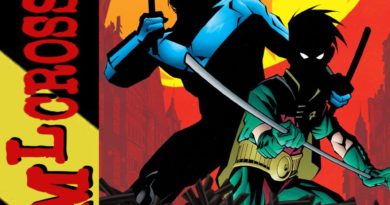NML Crossing, Episode 054 – Batman: Shadow of the Bat #84 (1999)

NML Crossing, Episode Fifty-Four
Batman: Shadow of the Bat #84 (April, 1999)
“Fear of Faith, Part Two: To Serve and Protect”
Writer – Devin Grayson
Pencils – Dale Eaglesham
Inks – Sean Parsons
Colors – Pam Rambo
Letters – Todd Klein
Edits – Illidge, Vincenzo, O’Neil
Cover Price: $1.99
Coming to you live from a wind-tunnel (for the first bit of the episode), it’s NML Crossing! Today is, among other things, air conditioner tune-up day… so, apologies for the ambient noise intermingling with my usual busted attempt at speaking!
Today we check back in with the Ark, where the Scarecrow is planting seeds left and right in order to compensate for the fact that No Man’s Land doesn’t stock his usual blend of fear toxin! It’s good stuff… check it out!
NML Crossing on Youtube




Scarecrow proves that he is just as dangerous without his fear toxin as he is with it. He was able to manipulate Father Chris, Mikey, and Huntress without any of them realizing it. I find it strange how Scarecrow is embraced my the Ark community while still dressed in his supervillain attire. I understand that the average reader wouldn’t recognize Johnathan Crane out of his costume, so having him in costume makes sense for reader clarity. But in story it doesn’t make sense to me.
My final thoughts on the graphic novel topic are: that no matter what you call it, Graphic Novel, Trade Paperback, Graphic Album , Collected Edition, Reprint Collection, or last Wednesday’s leftovers, as long as you enjoy the stories, that is all that matters. A rose by any other name…………yadda yadda yadda.
Strangely though I recently read a column by Biran Cronin over ar CBR that explains the origin of the name “Trade Paperback” and how it didn’t used to mean what comics fans use it to mean now. And it goes back to those Sons of Marvel collections you mentioned.
Whart article was that? I’m interested in how TPB usage/definition has evolved.
I also largely am just, as long as you enjoy the stories, that’s all that matters. The one caveat: for academic writing (literary or historical) I do think nuanced terminology would help.
And, yeah, people forget Scarecrow is a smart guy with vast psychiactric knowledge, so assuming his only weapon is fear gas is a big mistake.
https://www.cbr.com/comic-book-fans-trade-paper-back-term/
How Comic Book Fans Mistakenly Claimed the Term ‘Trade Paperback’ as Theirs
1) Reading omnibuses is definitely a chore. I only have a few, like the Milestone compendium (maybe not technically an omnibus bc it’s not a hard cover, but the page count is the same as omnibuses), which I have because there are no trades/graphic novels for Milestone other than that. I do get individual issues when I get a chance, but that leaves large holes in my collection.
2) I always like Legends of the Dark Knight’s original focus and stories. As it moved away from that, I still enjoyed its stories overall, but I feel like its general reason for being, and being unique, was largely lost when it did that. It occurred to me that Marvel is doing a lot of minis like this (Silver Surfer with Marz and Lim, Peter David on Symbiote Spider-Man and Joe Fixit Hulk minis), but DC doesn’t seem to do it as much from my perspective.
I wonder why that is. Why did DC do this for such a big book in LotDK decades ago, but largely isn’t doing something like it now, even in minis? Why did Marvel decide to start doing this relatively recently with their minis? I won’t say these Marvel minis are perfect, and neither was LotDK, but I like these approaches as a way to have a different flavor/era of a character consistently on the rack.
3) The last 10 years of memorable stories topic? I think there are some more than you were mentioning, but I do think there aren’t as many as there were in other decades pre-2000s. Company wide crossovers, multiple times a year (maybe even quarterly) definitely has caused too much disruption to have most stories gain and maintain steam. I also feel like the crossovers have gotten much bigger; the 90s had plenty of crossovers, but they largely remained in a family of books. When it’s done that way, it seems easier to keep building the pre-crossover story.
Decompression also hurts in this manner, I think, partly because it means there’s a lot less story arcs being created, so there’s less chances there will be more memorable ones. But I also think decompression, ironically, leads to focusing too much on just what is important in that storyarc, which leaves supporting casts and subplots developing less, in turn creating shallower stories.
In the last 10 years, I’ve liked Tomasi’s Superman run (yes, it was inconsistent, but I thought Clark and Lois on the farm raising young Jon is a great concept that was taken away too early by ageing Jon up). Although I didn’t like the ageing up, I do like Taylor’s Superboy/Superman Jon Kent stuff. Krakoa stuff, again inconsistent, is still a great story that seems like it’ll be referred to a lot over the years. Aaron’s Thor stories are partly in this last 10 years, and I’d say those were great stories that will be referred to a lot Most things Al Ewing done are great and will be at least referred to by him for years after (I like Eve Ewing too). I’m sure I’m forgetting some, but I do think part of the reason it seems like there are less memorable stories is because of industry changes mentioned above, but part of it also (for me, at least) is that I read a lot less Marvel and DC now than I used to, especially newer comics.